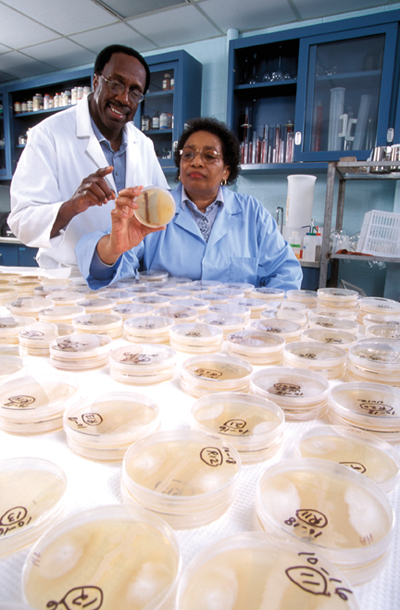
Controlling Fungal Pathogens
By Sharon Durham Agricultural Research Service (ARS)
Features New Technology ProductionResearchers identify what inhibits growth of Fusarium verticillioides
A key bacterial compound that inhibits the growth of the plant pathogen
Fusarium verticillioides has been identified by Agricultural Research
Service (ARS) scientists. The compound could help protect plants,
livestock and poultry from fusarium infection.
A key bacterial compound that inhibits the growth of the plant pathogen Fusarium verticillioides has been identified by Agricultural Research Service (ARS) scientists. The compound could help protect plants, livestock and poultry from fusarium infection.
 |
|
| Inhibiting fungal growth After using ultraviolet light to induce mutations, microbiologists Charles Bacon and Dorothy Hinton screen petri dishes of Bacillus mojavensis bacteria for growth on media amended with fusaric acid. Growth on such media reflects resistance to fusaric acid. Advertisement
|
The compound is produced by Bacillus mojavensis strain RRC101. Finding better controls for F. verticillioides is important because fumonisin mycotoxins, especially fumonisin B1,are toxic to livestock and poultry.
Microbiologist and research leader Charles Bacon and his team at the ARS Toxicology and Mycotoxicology Research Unit in Athens, Ga., identified Leu7-surfactin as the inhibiting compound that controls F. verticillioides. The research team includes microbiologist Dorothy Hinton, chemist Maurice Snook and technician Trevor Mitchell. Their study was published in the April 2009 issue of the Journal of Agricultural and Food Chemistry.
B. mojavensis is a plant-residing bacterium that can be used to control fungal diseases in corn and other plants. Though B. mojavensis is known to work as a biocontrol agent, the specific substance responsible for inhibition of Fusarium was not identified until recently.
The Leu7-surfactin was isolated from growing the bacterium in liquid cultures. In lab tests, the compound proved effective in inhibiting growth of the fungus. Surfactin has a detergent-like activity that dissolves the lipid membranes inside the fungus, eventually killing it.
In Bacon’s tests, Leu7-surfactin was effective at controlling F. verticillioides at very low concentrations of 20 micrograms per litre of liquid, making it more efficient to use. In addition to its antibiotic effects, surfactin can be used in textile manufacturing, environmental remediation, and fossil fuel recovery. This compound’s properties create great potential for biotechnological and biopharmaceutical applications.
Bacon and his colleagues examined all currently available strains of B. mojavensis and found that all of the strains are endophyticóliving within the plantóand all were active against F. verticillioides and other fungi in lab tests. The genus Bacillus is known for the production of more than 24 antibiotics, several of which are fungicidal with the potential to control plant diseases.
ARS is the principal intramural scientific research agency of the U.S. Department of Agriculture.
Print this page